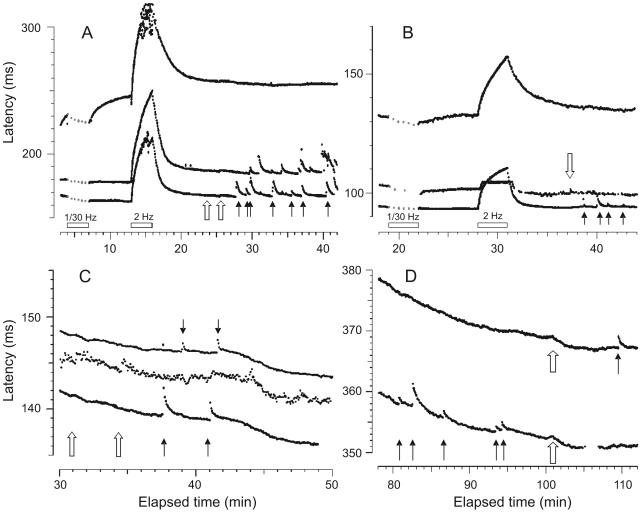Figure 2.
Four panels showing examples of simultaneous recordings of two or more C nociceptors in patients during sympathetic maneuvers, one (A) without and three (B-D) with concurrent single-fiber sympathetic efferent recordings. (A) CRPS I patient (patient #11, Table 1): Recording of three units, the fastest two (bottom) are mechanosensitive nociceptors and the slow unit a mechano-insensitive afferent, as based upon slowing of conduction velocity after the stimulus pause and upon receptor responses to mechanical stimuli (solid arrows). During startle (open arrows) there was a subtle generalized slowing of the three fibers, due to skin cooling from reflex vasoconstriction, but no ectopic discharge. (B) Patient #10 (CRPS I): Three units, identified (going from short to long latency) as a mechano-sensitive nociceptor, a sympathetic efferent and a mechano-insensitive afferent. During reflex activation of the sympathetic efferent by startle (open arrow) no excitation of either type of nociceptor was recognized. The mechano-sensitive nociceptor readily responded with bursts to mechanical stimulation (solid arrows). (C) Patient #3 (CRPS I): At this intraneural site, two CMH nociceptors and an active sympathetic efferent (in between) were recorded simultaneously. Despite spontaneous activity of the sympathetic efferent fiber and its reflex activation (open arrows), no activation was seen for the nociceptors which otherwise readily discharged upon mechanical stimulation (solid arrows). (D) Patient #2 (CRPS I): A recording of two mechanosensitive C nociceptor afferents, without concomitant sympathetic efferent recording. Mechanical stimuli briskly activate the fibers (black arrows), while sympathetic maneuvers only induce a gradual cooling-related slowing (open arrows). The gradual shortening in latency seen for all the units in panels C and D was due to warming of the skin by an infrared lamp.

